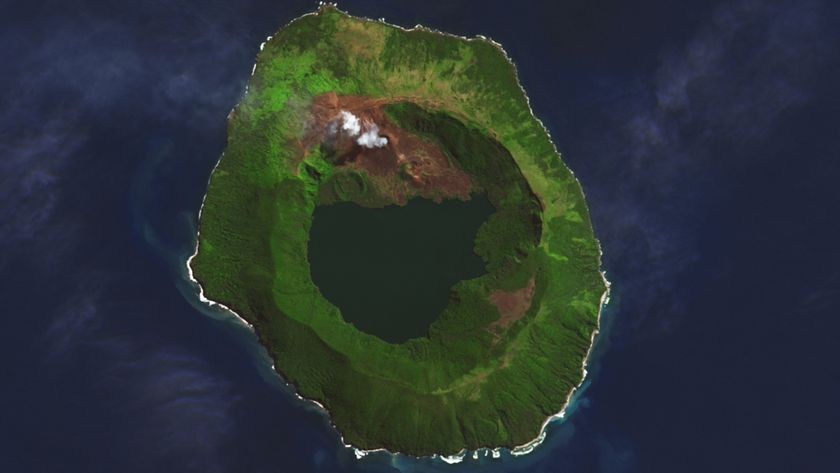
Water Security in an Unpredictable World (Op-Ed)

Giulio Boccaletti is managing director of Global Water at The Nature Conservancy (TNC). This Op-Ed was adapted from a post on the Global Water Forum. He contributed this article to Live Science's Expert Voices: Op-Ed & Insights.
This has been an unpredictable winter for the northern hemisphere. The 2014 Winter Olympics is wrapping up in a balmy Sochi, Russia, where they have artificially produced snow in bulk, and some say, where it might well be impossible to host winter games again within 50 years due to warming temperatures.
Meanwhile, California has seen record low snowpack — a critical source of fresh water for California farms and homes for the rest of the year.
On the other end of the spectrum, the "polar vortex" has put a hard freeze on large portions of the United States, stalling out regional economies, while leaving the more northern icepacks — those in Alaska and Greenland, for example — susceptible to unusually warm temperatures.
This winter's extremes, the record summer heat and drought in different parts of the world in recent years, and the "100-year storms" happening seemingly every year, of late, are sending a clear message: Unpredictable is the new normal.
The implications of this reality cut across all aspects of our lives. And, it starts with our water future.
Water — the world's silent currency — is a fundamental determinant of global economic growth. As the foundation of economies and societies, the global water system carries a roughly $500 billion annual price tag — a cost expected to double as several billion new consumers are born.
Sign up for the Live Science daily newsletter now
Get the world’s most fascinating discoveries delivered straight to your inbox.
Historically, people have built water infrastructure — dams, levees, canals and water treatment plants — based on the expectation that they will reliably serve our needs for decades, or even centuries. They have been built to withstand the most predictable events — based on long historical time series of hydrological and climate data — with the assumption that things will remain largely unchanged.
But, things are changing, and changing fast. As a result, society cannot just "engineer" a sustainable water future. As current infrastructure becomes increasingly inadequate in the face of a changing climate and a rapidly urbanizing world, we must base our future choices on a broader portfolio of possible solutions.
In this reality, the role of nature in securing a sustainable water future becomes critically important.
Take flood protection on the mighty Mississippi River, for example. My colleague, Jeff Opperman, a senior freshwater scientist and the leader of the TNC hydropower practice, wrote a great story about this a couple years ago on our Conservancy Talk blog.
In 1927, a 100-year flood struck the lower Mississippi. More than 100 levees failed or were overtopped, killing hundreds of people and displacing more than half a million from their homes. The disaster proved that people could not completely depend on our assumptions of how the most extreme weather events would behave, nor could we depend on the solution — a levees-only, "walled off" approach — that we thought would protect us from such events.
In direct response to this disaster, the U.S. Army Corps of Engineers began looking at the entire river basin for better flood-protection options, rather than relying solely on the disjointed system of levees. That new approach included setting aside floodplain areas, which could reconnect to the river during major flood events — thereby giving the river more room to spread its floodwater and reducing pressure on levees.
Fast forward to another 100-year storm on the Mississippi in 2011 . Despite the fact that this storm carried even more water than the 1927 storm, none of the levees failed, damage to property was relatively minimal, and there was no loss of life. By blending nature with built solutions, the Corps of Engineers was able to expand the set of possibilities that the Mississippi River basin was prepared to absorb.
Nature is resilient, cost-effective and adaptable — whether it's floodplains along the Mississippi or healthy watersheds that can help us more sustainably secure drinking water amidst increasing demands. [Rising Seas Could Threaten Drinking Water Supplies ]
The challenge in achieving blended, more flexible, water solutions is one of scale. Even if natural infrastructure accounted for roughly 10 percent of the anticipated future cost of global water systems, nations would still be looking at roughly $100 billion in investment in such solutions — an order of magnitude larger than the current collective size of the conservation community.

Achieving scale, therefore, will require leadership from businesses, governments and communities. We must pivot away from the traditional "white coats" management of water in the background of society to an active management of shared risks by all parts of society.
To motivate leadership and drive investments, we must continue to demonstrate the power of nature in helping us manage against those risks as resources become increasingly constrained.
As extreme droughts increase in frequency, farmers will need to grow more on less land, using less water. As 100-year storms become more frequent, governments and dam builders will need new tools and science to enable new water infrastructure projects that optimize the diverse functions of an entire river basin. And, as urban populations balloon, everyone will need to invest more in protecting the world's natural sources of drinking water.
While Russia may have been able to engineer the 2014 Olympics in a sub-tropical location that appears to be phasing out its ability to support winter sports, society won't be able to engineer a sustainable water future in this less-predictable world without looking to nature to help us.
Follow the author @G_Boccaletti. This Op-Ed was adapted from "In an Increasingly Unpredictable World, We Must Secure Nature to Secure our Water"on the TNC blog ConservancyTalk. The views expressed are those of the author and do not necessarily reflect the views of the publisher. This version of the article was originally published on Live Science.













